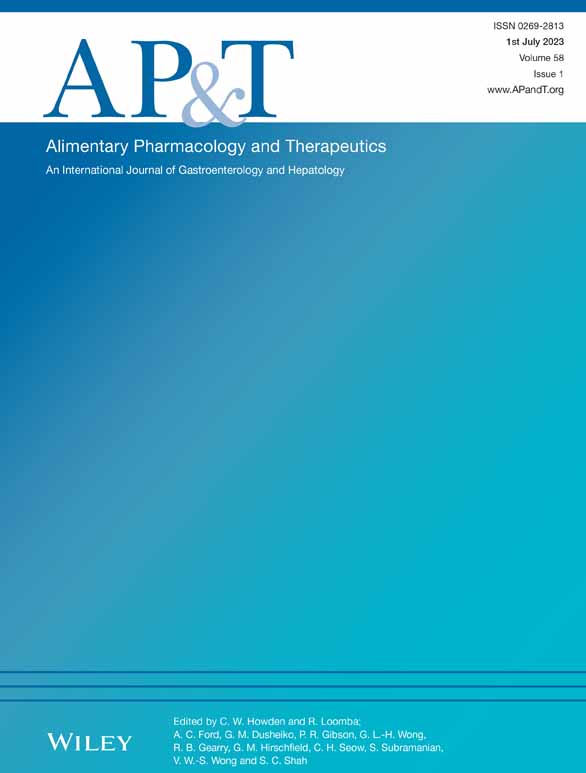Letter: Post-COVID-19 disorders of gut–brain interaction (DGBI)—just post-infectious or a multifaceted entity? Authors' reply
LINKED CONTENT
This article is linked to Marasco et al papers. To view these articles, visit https://doi.org/10.1111/apt.17513 and https://doi.org/10.1111/apt.17549
We read with interest the letter of Siah et al commenting on our meta-analysis estimating the rate of post-COVID-19 functional dyspepsia (FD) and irritable bowel syndrome (IBS).1 In our study, we found that post-COVID-19 FD was reported by 4% of patients and IBS by 12% of patients, but fell to 4% when considering only high-quality studies. COVID-19 survivors were found to be at risk for IBS development compared with controls, confirming the findings of our previous prospective study.2, 3
We agree with Siah et al that the pathogenesis of gastrointestinal symptoms during acute and long COVID-19 is complex and multifactorial. We recently summarised the mechanisms underlying acute COVID-19 gastrointestinal manifestations, which included mucosal and systemic inflammation, dysbiosis, intestinal barrier dysfunction and immune activation,4, 5 most of them resembling those postulated for IBS pathogenesis.6
Evidence is accumulating to support the biological plausibility for a direct or indirect involvement of the enteric nervous system (ENS) in SARS-CoV-2 infection.7 Indeed, in addition to their strong neuro-invasive potential,8 coronaviruses can lead to inflammatory and immune activation in the intestine. This may cause alterations in the ENS, enteroglial cells and intestinal smooth muscle, all involved in symptom generation.5 These alterations may activate sensory fibres conveying information to the central nervous system, which may contribute to symptom generation such as vomiting and diarrhoea described in COVID-19.5 The clinical phenotype of postural orthostatic tachycardia syndrome (POTS) reported by Siah et al. is quite different to that of disorders of gut–brain interaction (DGBI) and composed of several neurological and systemic symptoms, while gastrointestinal symptoms are not the main actors on the scene. Therefore, since the diagnosis of DGBI, including IBS, is primarily made by a symptoms-based approach with alarm symptom exclusion and minimal diagnostic assessments, an accurate patient history and symptom characterisation may help in distinguishing between the above-mentioned conditions in order to avoid misdiagnosis.9, 10
We agree that COVID-19 is associated with the increased levels of stress, anxiety and depression, which may contribute to gastrointestinal and extra-intestinal symptom development and persistence.5 Besides, it is recognised that DGBI and, particularly IBS, are associated with overlapping psychosocial illness.9 As an example, patients with IBS with predominant constipation have more anxiety, whereas depression is more common in IBS with predominant diarrhoea.9 In our recent large prospective study,3 we also found that patients with COVID-19 showed a significantly higher rate of depression compared with controls at 6-month follow-up according to the hospital anxiety and depression scale, and a similar trend was observed for anxiety at 12-month follow-up. When we assessed factors associated with the development of post-COVID-19 IBS after 12 months from the acute COVID-19 hospitalisation, we found the presence of anxiety at 6 months to be significant, although only on univariate analysis. Hence, we believe that the psychological impairment caused by COVID-19 can have an additional role for the development of long gastrointestinal COVID-19 manifestations, together with dysbiosis, gut dysmotility, increased intestinal permeability, modifications of enteroendocrine cell function and serotonin metabolism, SARS-CoV-2 nucleic persistence and persistent aberrant immune activation.3
AUTHOR CONTRIBUTIONS
Giovanni Marasco: Data curation (lead); writing – original draft (lead); writing – review and editing (lead). Marcello Maida: Writing – review and editing (equal). Cesare Cremon: Writing – review and editing (equal). Raffaella M Barbaro: Writing – review and editing (equal). Vincenzo Stanghellini: Writing – review and editing (equal). Giovanni BARBARA: Visualization (equal); writing – original draft (lead); writing – review and editing (lead).
ACKNOWLEDGEMENTS
Declaration of personal interests: None.
CONFLICT OF INTEREST
The authors declare no conflict of interest.
FUNDING INFORMATION
The study was supported in part by the Italian Ministry of Education, University and Research and funds from the University of Bologna (RFO) to G.B. G.B. is a recipient of an educational grant from Fondazione del Monte di Bologna e Ravenna, and Fondazione Carisbo, Bologna, Italy. GB is a recipient of the European grant HORIZON 2020 Framework Programme 2020-SC1-BHC-2018-2020/H2020-SC1-2019-Two-Stage-RTD-DISCOVERIE PROJECT. M.R.B. is a recipient of a grant from the Italian Ministry of Health (Ricerca Finalizzata GR-2018-12367062). The funders had no role in study design, data collection and analysis, decision to publish or preparation of the manuscript.
CONFLICT OF INTEREST STATEMENT
The authors' declarations of personal and financial interests are unchanged from those in the original article1.




